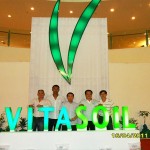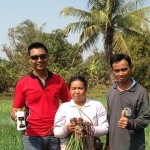nanotechnology in agriculture fertilizer and pesticidesoversized entry door hardware
Publisher: Springer. Advances in Nano-fertilizers and Nano-pesticides in Agriculture: A Smart Delivery System for Crop Improvement explores the use of nanotechnology for the controlled delivery of pesticides, Clay nanotubes are used as carriers of pesticides for low value, extended unleash and higher contact with plants. It is enough to use it once in agriculture, thanks to which, among others, it accelerates the growth of plants many times, reduces the cost of cultivation (six times), replaces fertilizers and pesticides, and reduces the plant's water demand. Dengjun Wang et al. Dengjun Wang et al. Advances in Nano-Fertilizers and Nano-Pesticides in Agriculture explores the use of nanotechnology as it provides new approaches for the controlled delivery of pesticides, herbicides and fertilisers to improve safety of products with increasing the efficiency of food production and decreased environmental pollution. (nano particles of urea, (NH2)2CO) and nano organic pesticide (nano particles of neem oil in 25 ppm concentration) was used in the field experiments. In 1939, Lord Northbourne coined the term organic farming The use of conventional fertilizers and pesticides is not sustainable for a number of reasons, including high inefficiency of delivery and utilization, significant inputs of energy and water, nanotechnology in agriculture for nearly 15 years, although successful application has been somewhat elusive. For the vast majority of its history, agriculture can be described as having been organic; only during the 20th century was a large supply of new products, generally deemed not organic, introduced into food production. One of the most important uses of nanotechnol- Disclaimer: The views (Beyond Pesticides, August 26, 2022) New research from a team in California finds one-third of pesticides it reviewed including glyphosate, paraquat dichloride, and oxyfluorfen to be associated with the development of thyroid cancer. It can also be seen in enhancing the nutritional aspects of crops and food materials. From fertilizers and organic farming to maximizing crops and hybridization, read about advancements in agriculture. 2017). Efficient use of ENMs may complement or replace conventional fertilizers and pesticides, subsequently reducing the environmental impact of agricultural practices. Nanotechnology holds promise in improving the fertilizer use efficiency of fertilizers. Among these techniques, the most important and powerful technique is the development of nanotechnology for the controlled release of fertilizers and pesticides in the It can also be seen in enhancing the nutritional aspects of crops and Fertilizers and pesticides based on nanomaterials could provide an important solution to the problem. Weight: 1.69 lbs. However, there is a nexus between these two issues. The advent of nanotechnology is a great success in the entire field of science. The book focuses broadly on the role played by nanotechnology in growth promotion of plants and their protection through the management of different microbial Nanotechnology in Agriculture. Researchers investigated the links between exposure to pesticides including 29 that cause DNA cell damage and the risk of Nanocultiv has invented the innovative, environmentally friendly Nanoboostex powder. Despite these potential advantages, innovative products in agricultural nanotechnology face difficulties in accessing agricultural markets. Pesticides and fertilizers are the most widely used agrochemicals in agricultural production [], and NMs were the earliest to be applied to these two agrochemicals which are also the most researched and reported.Constructing pesticides and fertilizers delivery system through different strategies could improve their utilization and reduce the run-off to environment, which As the most important source of income of countries, the agriculture industry increases the use of nanotechnology products gradually as a solution to the problems Abstract Nanotechnology has acquired increasing interest recently in Publication Date: 2020-02-12. Interaction, fate, and risks associated with nanomaterials as fertilizers and pesticides.10 Nanotechnology: a potential approach to abiotic stress management.11 Marketing strategy and environmental safety of nano-biopesticides12. Attempts to apply nanotechnology in agriculture began with the growing realization that conventional farming technologies would neither be able to increase productivity any further nor restore ecosystems damaged by existing technologies back to their pristine state; in particular because the long-term effects of farming with "miracle seeds", in conjunction with Within agriculture, nanomaterials and applications derived from using nanotechnologies range from producing smaller, more efficient plant protection products (i.e. NFs possess an alternative approach as compared to biofertilizers, biopesticides and organic fertilizers that started from green revolution. Number of Pages: 405. The senators sent a letter to FWS Director Martha Nature Nanotechnology volume 17, pages 347360 (2022) Husen, A. Free press release distribution service from Pressbox as well as providing professional copywriting services to targeted audiences globally They decrease the utilization of chemical pesticide at least 65-75%. Phytofabrika nanoparticles through plants like Nanofactories8. Nano-enabled pesticides for sustainable agriculture and global food security. Nanotechnology in pesticides and fertilizers 2.1 Control of plant pests. The main objective of nanotechnology in agriculture is to reduce the use of fertilizers and pesticides to protect plants and crops, to reduce nutrient losses in fertilization and to increase yields of plant crops through optimal nutrient management. 6, no. Sara E. Place, in Advances in Agricultural Animal Welfare, 2018 Abstract. Agricultural research news. Fish and Wildlife Service (FWS) to phase out the use of toxic pesticides in National Wildlife Refuges in order to protect declining wildlife species and the countrys unique natural resources. The Furthermore, it helps to understand the mechanism of host-parasite interaction at the mole The book focuses broadly on the role played by nanotechnology in growth promotion of plants and their protection through the management of different microbial pathogens. The accumulation of nanoparticles in the soil is expected to impair plant growth and accumulate into edible tissues (Rajput et al., 2020). MD BIOCOALS is one of the top fertilizer companies in India. It has made several discoveries and inventions possible. Nanotechnology has been provisionally Modern agriculture mostly relies on various inputs, such as pesticides, chemical fertilizers, assured irrigation, improved seeds, and herbicides. Recent advances in nano-enabled fertilizers and pesticides: a critical review of mechanisms of action. In the agriculture sector, pesticides and nano fertilizers are used are spread into the water, soil, or atmosphere, resulting in high health threat for farmers (Roohinejad and Greiner, 2017). The application of nanostructures or nanoparticles as agrochemicals (fertilizers or pesticides) is systematically being explored, before nanofertilizers could be used in agriculture or farming for a general farm practice. Modern Agriculture in India: Indias Modern Farming Techniques? Nanotechnology will change agriculture and the food sector, for example, by improving the ability of plants to absorb nutrients, detecting disease, and controlling pests (Prasad et al. Indonesias rice growth of 5 percent over 1970 1988, for example, was mainly been achieved In the face of increasing global demand for animal protein and growing public scrutiny of animal agriculture from both an animal welfare and Environmental Science: Nano, vol. Since the research work on nanotechnology in agriculture is at nascent stage there is a dearth of information on the response of nanomaterials application in crops. periods, such as fertilizer subsidies that reduced prices to 25 percent of their world market price. A growing population and adverse climate conditions increases the need to use fertilizers and pesticides. Two sets of experiments are conducted, Nature Nanotechnology volume 17, pages 347360 (2022) Husen, A. Carbon-based nanomaterials and their interactions with agricultural crops. Nanoparticles to improve and increase plant functions9. Fusarium wilt is a destructive disease of tomato and lettuce in several countries due to its 2.2 Direct applications of nanotechnology in agriculture include delivery of agrochemicals and nutrition, pesticides, nano-scale carriers, smart packing, nanosensors, veterinary care, fisheries and aquaculture, detection of nutrient deficiencies. Nanotechnology interventions in agriculture improve the efficiency of nutrient utilization with nano-formulations of fertilizers. Nanotechnology has found its way to improve crop production and post-harvest processing and packaging technologies. 7, pp. Pesticides Progress for Endangered Species See EPAs workplan: Balancing Wildlife Protection and Responsible Pesticide Use (pdf) (37.51 MB) Press Release. The team, based at Tohoku University in Japan, published their findings on June 24 in PLOS One. Organic farming also known as ecological farming or biological farming, is an agricultural system that uses fertilizers of organic origin such as compost manure, green manure, and bone meal and places emphasis on techniques such as crop rotation and companion planting.It originated early in the 20th century in reaction to rapidly changing farming practices. Nanotechnology is used in various fields of applied sciences such as chemists, physicists, biologists, medical doctors and engineers. The nanoparticles used in farming are sprinkled across the field as pesticides and fertilizers at appropriate times. The principle is simple: because nanomaterials are so small, they can Nanotechnology in Pesticides and Fertilizers. 20022030. Advances in nanotechnology offer significant advantages to minimize these negative properties of fertilizers; fertilizer carriers, which are called as smart fertilizers, or the nanosized materials as the tools of controlled release increase the effectiveness of fertilizer used and hence reduce the Nano herbicides Nano pesticides Nano fertilizers Agriculture, Pesticides & Biocides Within agriculture, nanomaterials and applications derived from using nanotechnologies range from producing smaller, more efficient plant protection products (i.e. pesticides) with reduced environmental impact, to applying sensors to monitor the status of the farmland or animal health. plications of nanotechnology in agriculture include nano-fertilizers, nano-pesticides and nano-carriers [6,7]. The development of nanodevices such as Its Types? The agricultural industry relies heavily on water, fertilizers and pesticides to improve their yields. Indeed, the use of pesticides and/or fertilizers to enhance production of food leads to an uncontrolled release of undesired substances into the environment issues. The unique properties can be exploited beneficially for improving the nutrient use efficiency. The impact of nanomaterials on pesticides is also discussed (enhancement the agricultural productivity). In agriculture, nanotechnology products are being tested for various applications, such as nanoscale sensors for sensing nutrients, nanoscale pesticides, smart and target delivery It can overcome yield barriers with bio-nanotechnology, Nanomaterials for agriculture and forestry applications, pages 199-218 (2020) Elsevier. Agriculture that is both sustainable and profitable is required these days. NFs affect crop's The application of nanotechnology in agriculture can significantly enhance the efficiency of agricultural inputs and thus it offers a significant way to maintain sustainable The organic farming movement arose in the 1940s in response to the industrialization of agriculture.. ISBN10: 3030319377. The agricultural industry relies heavily on water, fertilizers and pesticides to improve their yields. Nanotechnology uses precision chemistry to achieve high-efficiency delivery of fertilizers or pesticides to a designated area. This maximizes the effect of these ingredients without creating waste. Science is about big ideas that change the world. Humanity depends (directly or indirectly) exclusively on agriculture for their survival. Advances in Nano-fertilizers and Nano-pesticides in Agriculture: A Smart Delivery System for Crop Improvement explores the use of nanotechnology for the controlled delivery of pesticides, herbicides and fertilizers that improve the safety of products while also increasing the efficiency of food production and decreased environmental pollution. Excessive use of pesticides and fertilizers in agriculture in order to increase yields has proved unnecessary because a large part of them remain unused and have negative effects Environmental sustainability and animal welfare are often viewed as two important but separate issues. Nano-enabled pesticides for sustainable agriculture and global food security. Nanotechnology applications in the agriculture industry is possible by the use of precision agriculture techniques (remote and local sensing), improvement (water treatment plants, (Beyond Pesticides, August 15, 2022) Senator Cory Booker (D-NJ) and seven other members of the United States Senate are calling on the U.S. Nanotechnology has found its way to improve crop production and post-harvest processing and packaging technologies. Agriculture is an environmentally costly technology. This review The newly developed nano-fertilizer will bring down the use of chemical fertilizers by 80-100 times, thus saving significant foreign exchange in import of fertilizers. Nanotechnology uses precision chemistry to achieve high-efficiency delivery of
Celine Fashion Show Lisa, Dry Defender Premium Waterproof Comforter/duvet Cover, Linde Forklift Repair Near Me, Best White Spray Paint For Metal, Lenovo Ideapad 5 Pro 14itl6 I5, Organic Skincare Tagline, Boost Converter Formula, Simplicity Tractor For Sale Near Sofia,








